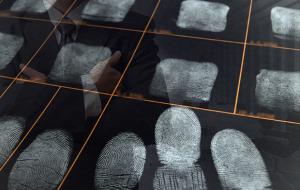Fingerprinting and the Modern Private Investigator
Even in our era of DNA testing to establish identity and presence at a crime scene, fingerprints remain a key tool in the crime investigator’s kit.
LOS ANGELES, CA, UNITED STATES, September 1, 2017 /EINPresswire.com/ -- While one can appreciate the newness of DNA profiling in the world of forensic science, people may be less aware of how relatively new the use of DNA profiling’s most obvious precursor, fingerprinting, is, at least in its application to crime investigation.
hat fingerprints had their uses was already known in ancient times. Archaeological evidence suggests that the Babylonians were using fingerprints in lieu of signatures as early as the second millennium BCE. While the Babylonian’s may not have been aware of the uniqueness of each person’s fingerprints, they clearly were aware of their efficacy as some kind of identifying mark. The Chinese used fingerprints (and hand- and even footprints) as means of “signing” clay tablets beginning around 300 BCE, and the use continued after the adoption of paper and into the middle ages. Perhaps the first recorded observation that a person’s fingerprints identified him uniquely came from a 13th century Persian physician in a discussion of the Chinese custom.
In the West, it wasn’t until the 18th century that Johann Mayer, a German physician, recognized the uniqueness of a person’s fingerprints. Even thereafter, the Western world preferred easily falsified written signatures for the ratification of documents and other identifying purposes.
Properly speaking, a fingerprint is the impression left by the friction ridges (or epidermal ridges) of the human fingers. These ridges have the biological function of increasing fingers’ sensibility. Embedded in the friction ridges are various oil glands, which explain why a person’s fingerprints leave traces on surfaces they touch. (Because the fingers of children have yet to develop their full compliment of oil glands, children’s fingerprints have the peculiar anomaly of disappearing very quickly from services on which they are deposited.)
Fingerprints are formed early in a fetus’ development. They begin to emerge around the 10th week of gestation, and are fully set by week 17 of a pregnancy. Fingerprints are formed by the varying tactile stresses upon a fetus’ developing fingers in the womb. The result of this essentially haphazard process is that no two people’s fingerprints are exactly alike. This includes identical twins, who, while perfect genetic copies of each other, do not have the same in utero experiences, and, thus, have differing fingerprints. (Anyone questioning the efficacy of DNA profiling can use the example of monozygotic twins as proof of the superiority of fingerprints in forensic investigations.)
While the uniqueness of fingerprints had been posited prior to 1800, another century had to elapse before their enormous value to crime investigations was recognized. (In the interim, a viable system for classifying fingerprints needed to be established. Several systems developed, all of which have become obsolete since computers assumed the formerly onerous task of compiling databases of fingerprints.) The first use of fingerprints in a criminal investigation came in a murder case in Argentina in 1892: a bloody print found at the crime scene led to the confession of Francisca Rojas to the murder of her two children. Rojas’ subsequent conviction established the efficacy of fingerprints for forensic purposes. The police have scarcely looked back since.
A fingerprint bureau was established in Calcutta in 1897; only in 1901 was one established by Scotland Yard, and not until 1906 was the fingerprinting of criminals established in the United States.
Fingerprinting is a commonplace in crime investigation and crime literature, with the fingerprint expert with his brushes and containers of powder a standard supernumerary in movies and on TV. There cannot be a person alive today who remembers a time when fingerprinting wasn’t part and parcel of crime investigation. And, yet, the technique is so new that one can’t help but wonder why fingerprints didn’t become part of forensic science sooner. Even in our era of DNA testing to establish identity and presence at a crime scene, fingerprints remain a key tool in the crime investigator’s kit. Technological progress continues to be made in the field as well, with the advent of such things as Live Scan technology allowing the electronic capture of fingerprints (as opposed to traditional paper-and-ink “rolling” of prints), showing that, far from being obsolete, the fingerprinting of criminals remains a key part of modern forensic science.
I began working as a private investigator before the advent of DNA profiling. While I am amazed at what forensic science is able to do with DNA evidence, that hasn’t caused me to lose my faith in fingerprint evidence. This is one situation where the new shouldn’t supplant the old: a good investigator should be able to appreciate both of these invaluable contributions to evidence.
At John A. DeMarr PI, we perform forensic investigations along the most thorough lines, including the use of fingerprint analysis where warranted. If you are in need of any type of investigation, please do not hesitate to contact our office at 877-433-6277 for a free consultation.
John DeMarr
John A DeMarr, PI
877 493 3463
email us here


